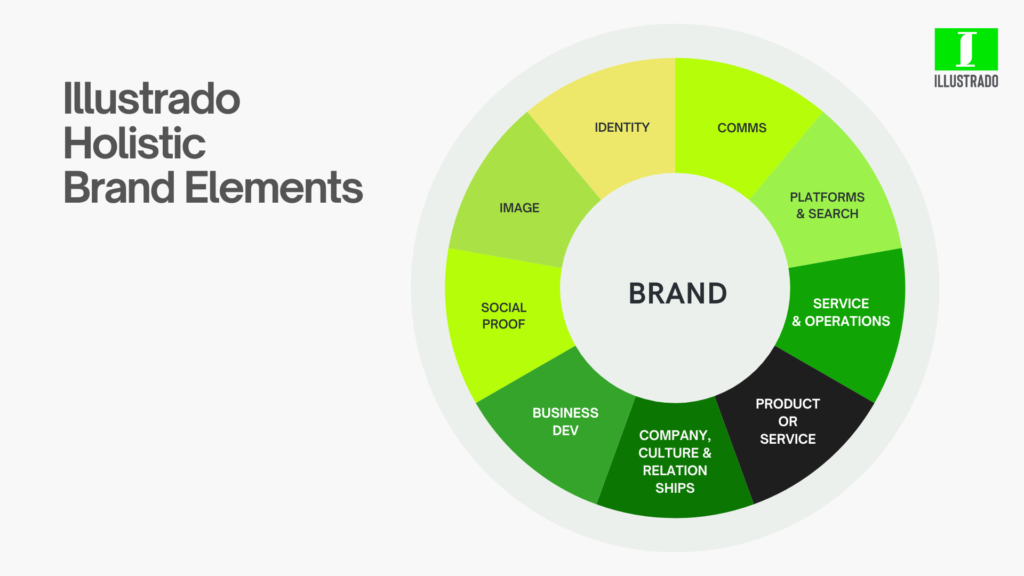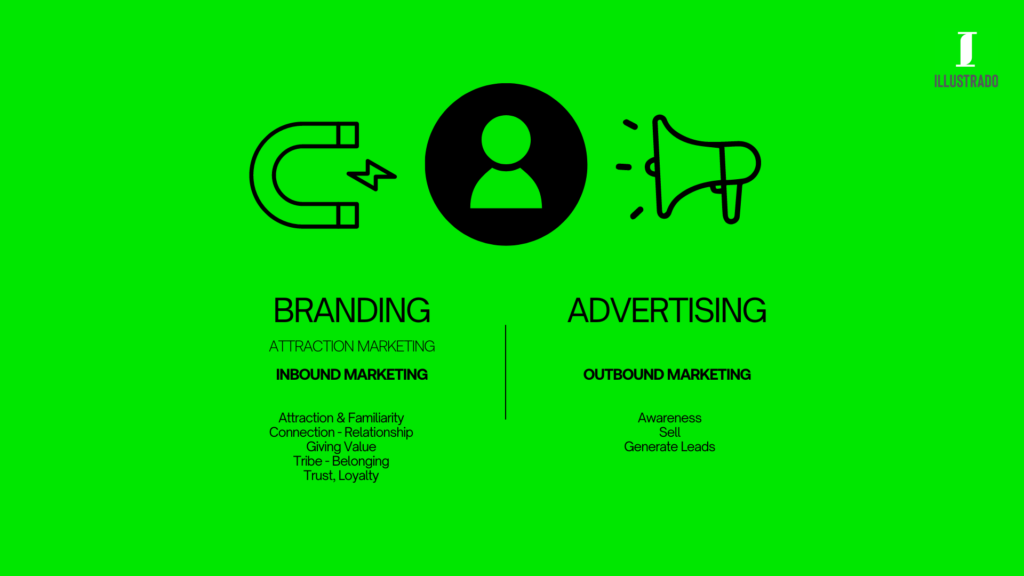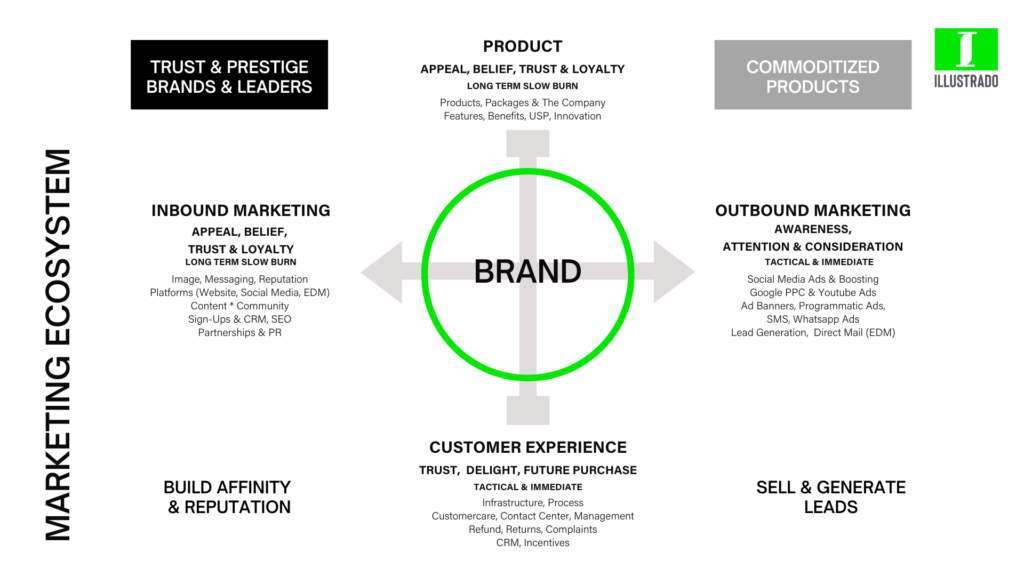Unlocking the Power of Digital Marketing
Digital marketing is accessible and powerful—but it’s also where many brands burn budgets with little return. Why? Because true growth doesn’t come from ads alone. It starts from the inside out—with a solid foundation rooted in core brand values, a standout product, and an exceptional customer experience. Only then can digital tools like websites, SEO, and social media amplify your brand’s voice and value.
This guide explores how to strategically balance inbound marketing and outbound marketing to drive trust, loyalty, and long-term business growth—turning digital marketing strategies into a growth catalyst, not just an expense.
True brand growth starts from the inside out, with a strong foundation built on core values, a quality product, and exceptional customer service.
The Power & Perils of Digital Technology
Digital platforms have revolutionized how brands connect, offering unmatched opportunities for brand growth, audience engagement, and even viral fame. Just look at icons like Justin Bieber, who launched his career via YouTube, or Carly Rae Jepsen, whose hit “Call Me Maybe” exploded globally thanks to social media. These stories prove how strategic digital marketing can amplify success.
But digital doesn’t just accelerate wins—it magnifies failures. Remember Pepsi’s infamous Kendall Jenner ad? Intended as a bold statement, it backfired spectacularly, becoming a global case study in brand missteps. The lesson? In the digital age, a single miscalculation can destroy brand reputation overnight.
So, is digital marketing the ultimate key to business success? No. Digital is just the vehicle. Without a strong foundation, even the best campaigns will collapse.
The Reality of Digital
Digital marketing tools offer immense potential—but they are just that, tools. They only deliver real results when built on a solid brand foundation. The reality is that many businesses, despite heavy investments in digital marketing, struggle to achieve meaningful outcomes because their brand fundamentals are weak.
For instance, spending thousands on social media ads won’t drive results if your brand message is unclear or your product doesn’t resonate with the target audience. Without a clear brand positioning, digital campaigns become costly experiments with little return.
Yes, digital technology allows brands to move faster, reach audiences more easily, and scale their efforts. But if the core of your business—your brand, product, or service—isn’t strong, no amount of digital marketing will lead to lasting success.
How to Properly Harness the Power of Digital
Digital technology and digital marketing are powerful vehicles for accelerating brand growth, but they are not the destination. To fully harness their potential, businesses must first build from the inside out.
Digital platforms don’t create value—they amplify what already exists. If your brand identity lacks clarity, direction, or depth, your digital efforts will only reflect that weakness. The principle of “Garbage In, Garbage Out” applies here: a weak brand will always yield weak results, no matter how sophisticated the digital strategy.
The most successful brands strike a balance between building a strong business foundation and leveraging digital tools for amplification. It starts with clear brand positioning, a compelling message, and a solid product—only then can digital marketing drive meaningful growth and scale.
The principle of “Garbage in, Garbage out” applies here: a weak brand will yield weak results, no matter how advanced your digital strategy is.

Building from the Inside Out
At the core of every business are its fundamental functions—sales and marketing. These two areas form the foundation for growth, driving the business forward.
SALES: This includes everything from prospecting and qualifying leads to closing deals and client servicing. Sales is where relationships with customers are built and revenue is generated.
MARKETING: The core elements of marketing revolve around the 4Ps—Product, Price, Place, and Promotion. In today’s environment, marketing has evolved to include a focus on Customer, Cost, Convenience, and Communication to ensure that customers’ needs and preferences are met.
However, what ties sales and marketing together—and ultimately strengthens the entire business—is the brand.
THE BRAND: A well-defined brand connects everything. It is built on a foundation of mission, vision, and values, and extends to brand identity, image, messaging, reputation, internal alignment, and company culture. A strong brand ensures consistency and cohesion—both internally with teams and externally with customers. It shapes perceptions, builds trust, and creates long-term value.
Once these fundamentals are solidly in place, the next step is amplification.
DIGITAL MARKETING: This is what brings everything—brand, sales, and marketing—to life on a larger scale. It becomes the vehicle for visibility, engagement, and growth. With the right digital strategies, you can extend your brand’s reach, drive awareness, and prompt meaningful action.
DIGITAL MARKETING TOOLS
- Websites act as your digital storefront—your brand’s primary hub where prospects and customers engage with your content and offerings.
• SEO (Search Engine Optimization) ensures that your brand is discoverable, helping potential customers find you exactly when they need your products or services.
• Social Media Platforms amplify your brand’s voice, helping you engage with audiences, build communities, and foster real conversations.
• Ads (PPC, Social, Programmatic) drive direct traffic, generate leads, and create instant visibility for your brand.
• Analytics provide actionable insights into performance and user behavior, allowing you to optimize campaigns for maximum impact.
• EDM (Email Direct Marketing) nurtures relationships with personalized content, promoting offers and maintaining brand presence over time.
• Mobile Marketing ensures your brand is accessible anytime, anywhere—reaching customers on their devices through ads, apps, and SMS.
• Automation streamlines and scales processes like lead generation and engagement, enhancing efficiency and allowing you to focus on strategy.
In essence, digital marketing amplifies your core brand, sales, and marketing efforts by leveraging the vast potential of the digital landscape. It ensures that your brand message is heard, your voice is amplified, and your business grows with measurable impact.
Brand Power
Consider Apple, now valued at over $3 trillion, a company known not only for its innovative products but for its deep connection with its audience. Apple transcends its physical products, whether it’s the iPhone or the Mac. Instead, the brand is built on innovation, design, a community-driven culture, and memorable campaigns that champion creativity and empowerment.
More than 95% of Apple’s products are manufactured in China, yet no other factory can replicate Apple’s success. Why? Because Apple’s strength lies not in its product assembly but in the power of its brand—the way it resonates with users, the way it innovates, and the unique experiences it provides at every touchpoint.

What is a brand?
A brand is not what you claim it to be; it’s what people say about you when you’re not in the room, as Jeff Bezos famously said. Branding encompasses every experience, interaction, and perception your audience has with your company, both externally and internally.
Most businesses focus heavily on external branding—the visual identity, messaging, and marketing campaigns—but fail to recognize that half of branding lies within the company itself: its culture, operations, and how employees embody the brand in every interaction with customers.
Let’s break down these key elements:
A) EXTERNAL BRAND ELEMENTS
- Identity: This is your brand’s visual face—logo, color palette, typography, and overall design. A strong identity goes beyond aesthetics; it consistently communicates your brand’s core values and personality.
- Image: This refers to the public’s perception of your brand. It is shaped by the experiences your audience has with your company. Every customer interaction impacts this image, from website visits to social media engagements.
- Communications: Brand communications include every message sent to the public, from advertising to customer service responses. Consistency in tone and message builds trust, while listening to customer feedback strengthens relationships.
- Platforms: Your brand lives across multiple platforms—websites, social media, physical stores—and each should deliver a cohesive experience that aligns with your brand identity and customer expectations.
- Social Proof: Reviews, testimonials, case studies, and user-generated content are forms of social proof that validate your brand. What others say about your company builds credibility and trust in ways that marketing alone cannot.
B) INTERNAL BRAND ELEMENTS
- Product/Service: Your brand is ultimately only as strong as the product or service you offer. If your product doesn’t live up to expectations, no amount of marketing can compensate.
- The Company: Internal governance, structure, and culture play a huge role in delivering on your brand promise. Companies that align their internal policies with their brand values are better equipped to deliver consistent and authentic customer experiences.
- Service and Operations: How your company handles customer service, logistics, and operations directly impacts your brand. Efficiency, responsiveness, and consistency are key in fostering trust and loyalty.
- Business Development: How your company grows—whether through partnerships, new markets, or product innovation—reflects your brand’s evolution and ambition. Strategic business development is essential for long-term success.
- Relationships and Culture: The relationships you build internally with employees and externally with customers and partners define your brand’s reputation. A strong, positive culture reflects a strong brand, ensuring that employees become ambassadors of your brand values.
Branding is about building connections and trust over time, while advertising is about driving awareness and generating leads.

Branding Versus Advertising
Branding and advertising serve different purposes but are often mistakenly thought of as one and the same. Branding is about building connections and trust over time, while advertising is about driving awareness and generating leads.
- BRANDING creates familiarity, loyalty, and long-term value by establishing emotional connections with your audience.
- ADVERTISING is more immediate and transactional, focused on generating quick results like leads or sales.
A company that only relies on advertising risks commoditizing its product and getting caught in price wars. On the other hand, branding allows a business to differentiate itself, cultivate loyalty, and build a lasting reputation.

Building the Marketing Ecosystem
A sustainable marketing ecosystem starts from the inside out—anchored by a strong brand and expanded through strategic inbound and outbound marketing. Each component plays a vital role in amplifying your message, building brand trust, and driving long-term growth.
1) START WITH YOUR CORE: THE BRAND
At the heart of your marketing ecosystem is your brand, which forms the foundation of your marketing efforts. This encompasses both your product and customer experience, ensuring that your audience connects with the core values of your business.
- a) Product
- The objective here is to build appeal, belief, trust, and loyalty in your offerings. This requires a long-term, steady approach that highlights the strengths of your product and innovation.
- Components: Products, Packages & The Company; Features, Benefits, USP, Innovation.
- b) Customer Experience
- Your customer experience should aim to create trust, delight, and encourage future purchases. This is where tactical, immediate actions are vital to reinforcing positive relationships.
- Components: Infrastructure, Process; Customer Care, Contact Center, Management; Refunds, Returns, Complaints; CRM, Incentives.
2) INBOUND MARKETING (BRAND OR ATTRACTION MARKETING)
Inbound marketing is an essential part of brand development itself. It establishes your brand’s credibility, builds appeal, belief, trust, and loyalty, and nurtures long-term relationships with your audience. Inbound marketing strategies attract customers organically by creating value and engaging with them through consistent messaging.
- This is a long-term, slow-burn strategy designed to solidify your brand’s position in the market while fostering deeper connections with your audience.
- Components: Identity, Image, Messaging, Reputation; Platforms (Website, Social Media, EDM); Content & Community; Sign-Ups & CRM, SEO; Partnerships & PR.
3) OUTBOUND MARKETING
With your brand and inbound marketing firmly established, outbound marketing drives immediate awareness and consideration. The objective is to generate attention and engagement through targeted, tactical efforts that bring in leads and prompt direct customer interactions.
- Outbound marketing focuses on achieving quick results, typically through paid advertising and direct outreach to your audience.
- Components: Social Media Ads & Boosting; Google PPC & YouTube Ads; Ad Banners, Programmatic Ads; SMS, WhatsApp Ads; Lead Generation, Direct Mail (EDM).
The Marketing Ecosystem in Action
A successful marketing ecosystem balances a strong brand foundation with strategic inbound and outbound efforts. When aligned, this approach amplifies trust, avoids price wars, and ensures long-term growth rooted in brand reputation and market relevance.


